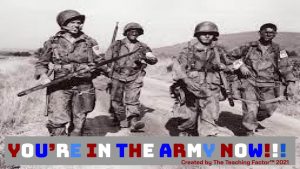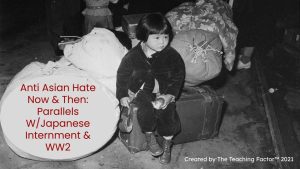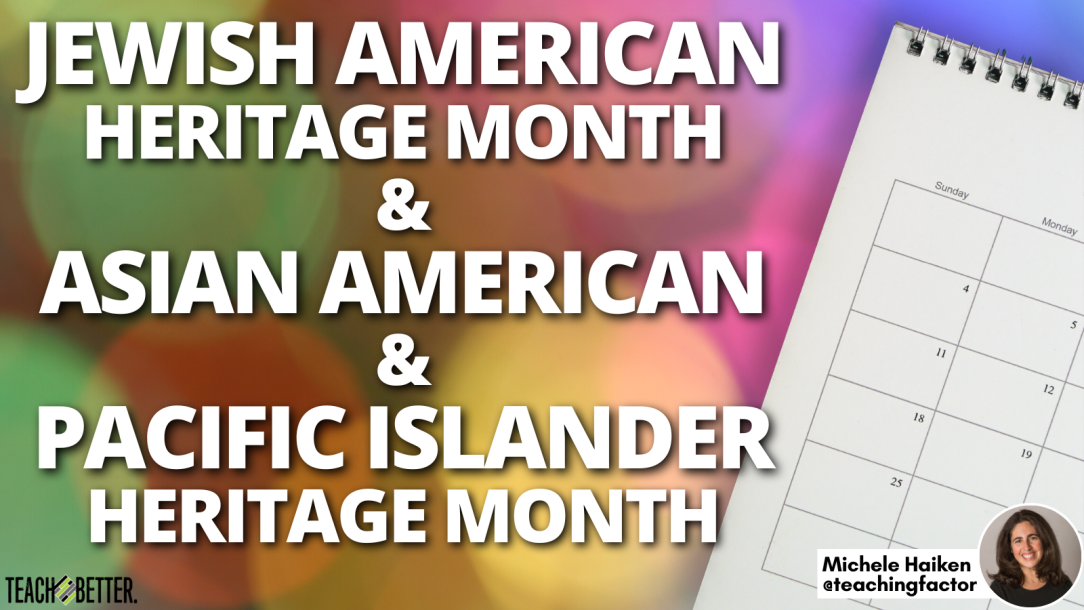TL;DR:
- May is Jewish American Heritage Month and Asian American and Pacific Islander Heritage Month.
- You can provide rich cross-curricular learning experiences on WW2 and the experiences, culture, and contributions of these groups.
The month of May is designated as Jewish American Heritage Month and Asian American and Pacific Islander Heritage Month. During this month, we honor “the generations of Jewish Americans and Asian and Pacific Islanders who have enriched American history and are instrumental in its success” (National Archives).
WW2, the Holocaust, and Japanese Internment
The month of May is when we study WW2, the Holocaust, and Japanese Internment in my 8th grade classroom. In both English and social studies, students read historical fiction, memoirs, and nonfiction texts of their choice about these topics. In history, students study the dates and facts. They read primary sources to understand the ramifications of the war on a global level.
The aim of this cross-curricular unit is for students to develop an understanding of the roots and ramifications of prejudice, racism, and stereotyping in any society. Additionally, students develop an awareness of the value of pluralism and encourage acceptance of diversity in a pluralistic society. One key facet is to not just learn about the victims. We also honor the Jewish and Asian American heroes who showed perseverance and were instrumental during this time.
The aim of this cross-curricular unit is for students to develop an understanding of the roots and ramifications of prejudice, racism, and stereotyping in any society. Click To TweetStudents learn about Japanese Internment. This includes the 442nd regimental combat team, a segregated Japanese American unit that is the most decorated unit in US History for their bravery and heroism. Students read the graphic novel They Called Us Enemy by George Takei. This helps them gain a child’s perspective of Executive Order 9066 and living in an Internment Camp in Takei’s memoir. Some students select to read Traci Chee’s We Are Not Free, a Printz Honor Winner young adult historical fiction text that was based on the author’s grandparents’ stories of being incarcerated during WW2.
HyperDocs
I have put together two different HyperDocs. A HyperDoc is a digital document such as a Google Doc where all components of a learning cycle are pulled together into one central hub for students to learn more. Within the HyperDocs, students are provided with hyperlinks to all of the resources. As a result, students are able to work at their own pace while learning about the diverse groups of soldiers who made up America’s military. A second HyperDoc examines Japanese Internment and its ramifications today. You can make a copy of the Military and the Japanese Internment HyperDocs when you click these links. Feel free to adapt these HyperDocs and personalize them for your students.


Additional Resources
Similarly, in studying the Holocaust, students read stories of survivors. They even have the opportunity to Zoom with a survivor to hear her story. You can connect with a speaker through the Jewish Heritage Museum’s Speakers Bureau in New York City. Additionally, students look at artwork and read poetry from the victims and survivors of the Holocaust to understand the horrors of this period in history. The Anne Frank House in Amsterdam offers a virtual tour online of the Secret Annex. This is where Anne and her family hid for more than two years during WW2 and where she wrote her diary.
Educational materials have been curated by The Library of Congress and the National Archives and Records Administration with primary sources about the Chinese Exclusion Act, the Annexation of Hawaii, and Japanese Americans during WW2. The National Endowment for the Humanities, National Gallery of Art, National Park Service, and United States Holocaust Memorial Museum has links and resources for teaching about the generations of Jewish Americans who have contributed to American history, culture, and society.
[scroll down to keep reading]Culminating Project
For our culminating project for WW2, students create their own multi-genre text on a specific topic and theme about World War II. This summative assessment and multi-genre project incorporates five texts (fiction and nonfiction) grounded in specific historical documents to highlight a common theme prevalent in WWII. Allowing students to be researchers and writers enables students to use higher-order thinking and comprehension skills. At the same time, students are tapping into 21st-century skills as digital citizens and creators. Students utilize technology for research and writing to produce a project that presents their understanding and learning of WWII and the Holocaust.
This May, consider ways to share stories, expose stereotypes and myths about Jewish and Asian Americans, and celebrate their rich culture and diversity.
About Michele Haiken
Michele Haiken, Ed.D is an educator, author, and blogger. She has been teaching for more than twenty-four years as a middle school English teacher and an adjunct professor in New York. Michele is the co-author of the forthcoming book Creative SEL: Using Hands-on Projects to Boost Social Emotional Learning (ISTE, 2023) and author of New Realms for Writing (ISTE, 2019), Personalized Reading (ISTE, 2018), and editor of Gamify Literacy (ISTE, 2017). Michele is passionate about empowering 21st Century learners, educational technology, and literacy so everyone can reach excellence. Read more on her blog theteachingfactor.com and connect with Michele on Instagram @teaching_factor and Twitter @teachingfactor.




